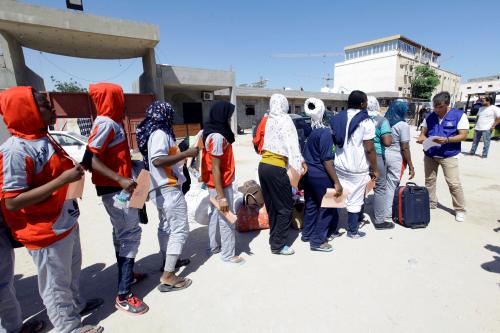Below is a viewpoint from Chapter 3 of the Foresight Africa 2018 report, which explores six overarching themes that provide opportunities for Africa to overcome its obstacles and spur inclusive growth. Read the full chapter on human development and poverty trends in Africa here.
The issues around refugees and migration remain some of the most hotly debated topics in Europe. With European per capita income roughly 11 times that of most of sub-Saharan Africa and tens of millions of young Africans with poor job prospects, the attraction of migrating to Europe is and will remain immense. While there is migration from all over the world into Europe, geography makes Africa the biggest potential source of migrants.
One approach that Europe (as well as others such as the United States) wants to take is to let in only skilled migrants. The aim here is to complement Europe’s skilled labor with carefully filtered immigration. The numbers would be small, making the absorption of these migrants easier in terms of cultural barriers.
In any case, taking in small numbers of skilled Africans will not alleviate the strong pressure from the millions left behind.
While this may be a desirable objective from the point of view of the rich countries, it would have mixed results for Africa. The investment in human capital that these migrants embody would be largely lost. Then again, remittances could be an advantage, as would possible return of some of these migrants to their home countries. In any case, taking in small numbers of skilled Africans will not alleviate the strong pressure from the millions left behind.
In fact, the futures of Europe and Africa are intertwined. A growing, hopeful Africa will diminish this hard-to-manage migration pressure. A prosperous Europe will present good markets for African products. Thus, Europe should address the migration problem with a long-term perspective by investing in Africa. Potential returns are great when one averages. But individual projects are riskier than elsewhere due to greater political uncertainty and regulatory deficits, as well as problems of transparency. This has constituted an important barrier for private investment, which is crucial given the scale of the challenge.
That is why the public policy must be active in risk pooling and de-risking by accepting to bear some of the risk or supporting insurance mechanisms, leveraging its scarce funding capacity. Innovative financial engineering can bring together the private, public, and philanthropic sectors and create a virtuous circle with huge benefits for both Africa and Europe. Africa needs 8 to 9 percent sustained annual growth to really take off and create the hope its young population needs. The world, and particularly Europe, will benefit from it. This is totally achievable if the public and private sector partner in reducing risk. The future depends on it.
The Brookings Institution is committed to quality, independence, and impact.
We are supported by a diverse array of funders. In line with our values and policies, each Brookings publication represents the sole views of its author(s).








Commentary
Foresight Africa viewpoint – Africa and Europe: Toward real partnership on migration
January 23, 2018